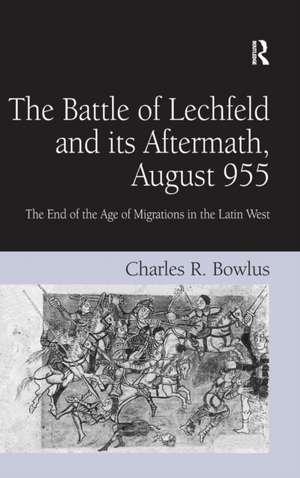The Battle of Lechfeld and its Aftermath, August 955: The End of the Age of Migrations in the Latin West
Autor Charles R. Bowlusen Limba Engleză Hardback – 14 iun 2006
Preț: 1057.09 lei
Preț vechi: 1289.13 lei
-18% Nou
Puncte Express: 1586
Preț estimativ în valută:
202.28€ • 211.73$ • 168.36£
202.28€ • 211.73$ • 168.36£
Carte tipărită la comandă
Livrare economică 31 martie-14 aprilie
Preluare comenzi: 021 569.72.76
Specificații
ISBN-13: 9780754654704
ISBN-10: 0754654702
Pagini: 247
Dimensiuni: 156 x 234 x 16 mm
Greutate: 0.52 kg
Ediția:1
Editura: Taylor & Francis
Colecția Routledge
Locul publicării:Oxford, United Kingdom
ISBN-10: 0754654702
Pagini: 247
Dimensiuni: 156 x 234 x 16 mm
Greutate: 0.52 kg
Ediția:1
Editura: Taylor & Francis
Colecția Routledge
Locul publicării:Oxford, United Kingdom
Cuprins
Contents: Preface; Introduction; Hungarian warfare; The reforms of Henry I in Saxony; Hungarians and the Latin West; The way to the Lechfeld; The way from the Lechfeld; Conclusion: Hungarian defeat - Ottonian Victory; Appendices; Bibliography; Index.
Notă biografică
Charles R. Bowlus is Emeritus Professor of History at the University of Arkansas at Little Rock, USA.
Recenzii
'The great virtue of this book is that bowlus has matched an excellent knowledge of the sources to an intimate knowledge of Bavaria and Hungary, producing a convincing account of this campaign and its consequences.' History ’This important contribution to military history...’ Medium Aevum ’...an important reinterpretation that is thoughtful, source driven, lucidly written, and often convincing. ...The Battle of the Lechfeld and its Aftermath is an exemplary case study of medieval military history that should be of interest not only to specialists, but also to those who seek a better understanding of warfare in early medieval society.’ Early Medieval Europe
Descriere
In August 955 the forces of Otto the Great annihilated a huge army of Hungarian mounted archers in an encounter known as the battle of Lechfeld. This book provides the first satisfactory explanation for the decisive nature of Otto's victory which effectively ended the incursions of steppe nomads into Western Europe. A detailed reconstruction of the battle is preceded by chapters analyzing 10th-century Germany and the strengths of nomadic styles of warfare. A pioneering aspect is the consideration of environmental factors, not only the limits they imposed on the expansion of the nomadic way of life into Europe, but also the impact the local environment had on the outcome of the battle.










